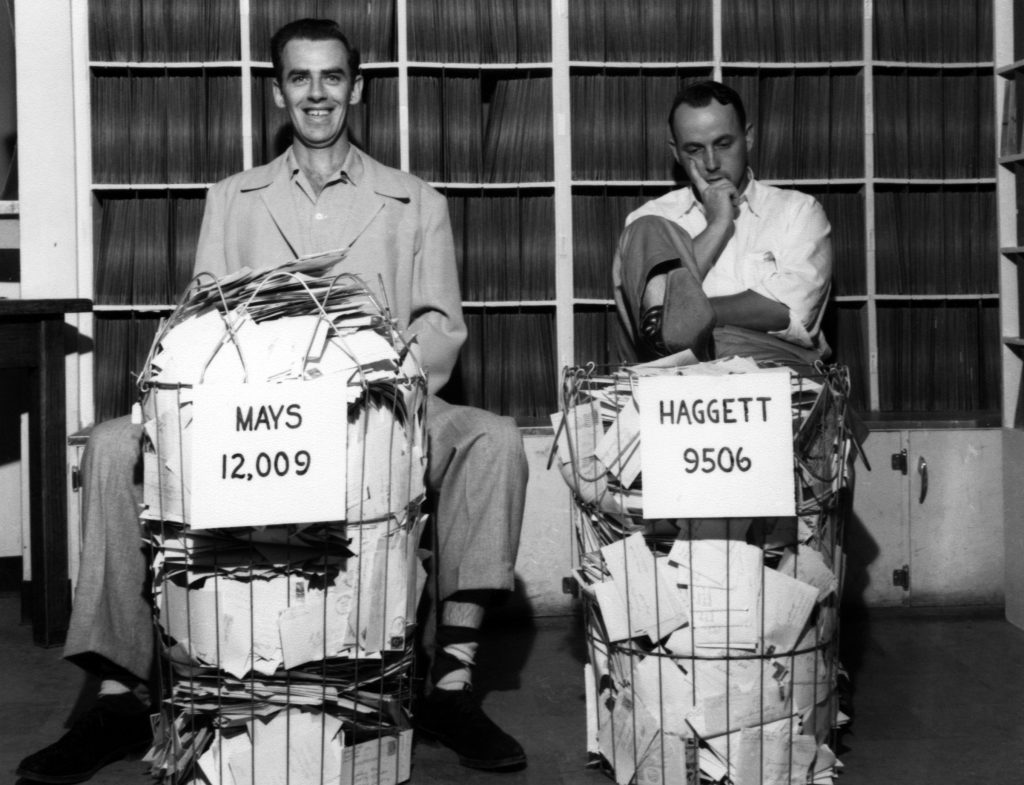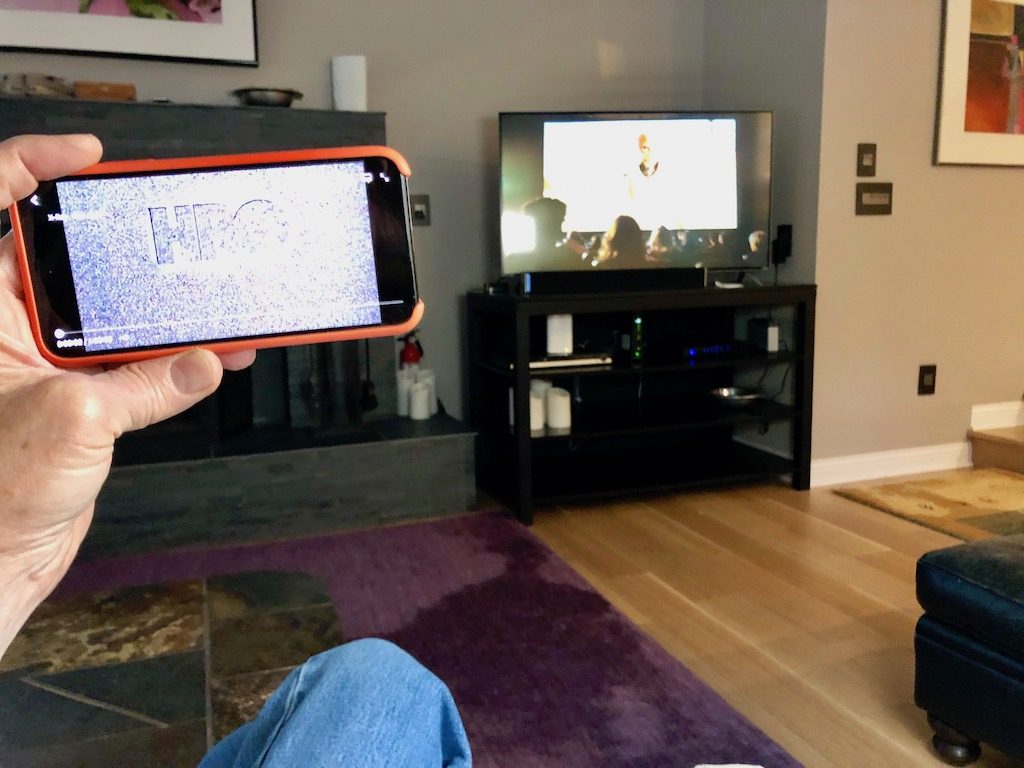I love the scene in Mississippi Burning where Gene Hackman grabs KKK man Michael Rooker’s testicles.
It came to mind while watching Get Shorty in which John Travolta’s character grabs James James Gandolfini’s character by the balls and tosses him down a flight of steps. I should compile a list of such scenes, right? Too late. Been a long time since I came up with an idea for a “best of” that hadn’t been done.
Category Archives: Media & Entertainment
Country vs. Pop
In one of the episodes of Ken Burns’ series on the history of country music, they trace the shift from country to pop music. I believe it was in the early 50’s. My father, John Mays, would have been at KBOA for several years by then and he had a better feel (and preference) for pop than country so he played that music while other announcers played different types. Rudy Pylant (Mr. Rudy) was known for Old Camp Meetin’ Time which was country gospel and “old time” music. Jimmy Haggett was — during this period — known as the country DJ.
The photo below was the result of a “popularity” contest in which listeners voted with 3-cent postcards.

This must have been an incredibly exciting time to be in radio, even at a small market station like KBOA. Nashville station WSM (home of the Grand Ole Opry) was featured prominently in the Burns documentary Haggett worked there at some point after leaving KBOA.
Country Music | A Film by Ken Burns
The Weight
I never tire of these. The face of each performer radiates joy.
Burning Man Art Tour 2019
True Detective (Season One): Philosophy of Rust Cohle
I was not a fan of what I think of as the early Matthew McConaughey but his later stuff really speaks to me. Mud (2012) and Dallas Buyers Club (2013). Top of my list is his portrayal of Rust Cohle in the first season (2014) of the HBO series True Detective. In the scene above (with Woody Harrelson) Rust shares his view of the cosmos.
True Detective (Season One) on iPhone with AirPods
My Apple AirPods continue to open up new worlds of sound. I watched (and liked) the first season of the HBO series True Detective (Matthew McConaughey and Woody Harrelson) on a TV. Last night I started watching the series again but this time on my iPhone with AirPods. As with Deadwood, it was a completely different experience. The music was far more powerful and evocative. The texture of the actors voices was richer. (You could almost hear the smoke when McConaughey exhaled) Not sure I can go back to listening to sound coming from across the room.
The Family
Recommended reading: Frat House for Jesus. The Entity Behind C Street.
Homicide: A Year on the Killing Streets
 “Homicide: Life on the Street is an American police procedural television series chronicling the work of a fictional version of the Baltimore Police Department’s Homicide Unit. It ran for seven seasons (122 episodes) on NBC from January 31, 1993 to May 21, 1999, and was succeeded by Homicide: The Movie (2000), which served as the de facto series finale.” (Wikipedia)
“Homicide: Life on the Street is an American police procedural television series chronicling the work of a fictional version of the Baltimore Police Department’s Homicide Unit. It ran for seven seasons (122 episodes) on NBC from January 31, 1993 to May 21, 1999, and was succeeded by Homicide: The Movie (2000), which served as the de facto series finale.” (Wikipedia)
I only recently learned the series was based on David Simon’s book Homicide: A Year on the Killing Streets (1991). Many of the characters and stories used throughout the show were based on events depicted in the book. The book was also the inspiration for the HBO series The Wire.
I just finished the book and it was as good as you would expect. Words like “gritty” and “raw” don’t begin to capture the characters, locales and dialogue. I recently purchased the DVD set of the NBC series. I watched the series when it aired but that was a long time ago and I’m sure I missed a lot of episodes.
Simon also wrote The Corner, a six-part HBO series that chronicled the life of a family living in poverty amid the open-air drug markets of West Baltimore. After I recover from Homicide, I’ll read The Corner. My recollection of the HBO series is of a very depressing story.
Most police dramas that make it to TV or cable are pretty week compared to Simon’s work. NYPD Blue was good but limited by being on network TV. If you enjoyed The Wire and Homicide, I highly recommend the books on which they were based.
Small screens, large screens
I grew up with television, a child of the 50s and 60s. TV screens started off small and got progressively larger. The bigger the screen the better with quality secondary (don’t recall ever hearing the word “resolution” in those days. The family TV was a massive piece of furniture that we watched from across the room. Today, even a struggling family is likely to have a big-ass flatscreen TV. I’m watching less “TV” these days but that might be about to change.
I recently started watching The Wire (again) and got about halfway through the series before Riley showed up. Once she started settling in I went back to the series but on my iPhone this time. I’ve never watched a lot of video (hard for me to call it “TV”) on my phone just because… well, the bigger the screen the better, right? Turns out, not right.

When my phone is in my lap (or on a table), it’s about 18 inches from my eyes. In the photo above the phone is about a foot-and-a-half in front of my face and — as you can see — about the same relative size as the TV across the room. But with much higher resolution and — with AirPods — much better sound.
We have Apple TV and HBO and Netflix but my default streaming source is Amazon Prime which has an excellent app. I’m now finding I watch part of a movie or series… pause… and come back to it. Something I never did before. And my viewing now happens away from the TV room.
This is old news for most of you but something of a revelation for me. I’m find the viewing experience far superior — in many ways — on the phone. Tiny screen for the win.

